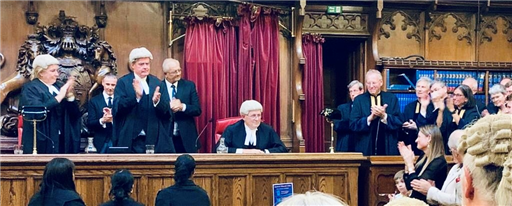
Child Maintenance in Cases of Equal Shared Care
Published: 21/11/2023 07:00

The situation: two parents share childcare seemingly equally but there is a significant income imbalance.
The issue: how is child maintenance determined? Does the Child Maintenance Service have jurisdiction? Does the Family Court have jurisdiction? Do neither?
This article aims to address these questions, albeit in circumstances where the relevant commentary in the Red Book states that a case deciding this point is awaited.1
Basic principles
The first chapter of the Child Support Act 1991 (CSA 1991) is entitled ‘The basic principles’ and this is our starting point. Section 1 CSA 1991 sets out that each parent of a qualifying child is responsible for maintaining that child. It further sets out that a non-resident parent shall be taken to have met their responsibility to maintain by making periodical payments as may be determined in accordance with the CSA 1991. It does not say how a parent who is not a non-resident parent would satisfy this duty to maintain.
A parent is defined in s 3 CSA 1991 as being a non-resident parent if:
‘(a) that parent is not living in the same household with the child; and
(b) the child has his home with a person who is, in relation to him, a person with care.’
A person (NB not necessarily ‘parent’) is defined as being a person with care if they are a person:
- With whom the child has their home;
- Who usually provides day to day care of the child (whether exclusively or in conjunction with any other person); and
- Who does not fall within a prescribed category of person (i.e. local authorities and foster parents with whom a child is placed when looked after by the local authority).
Readers will be familiar with the various agencies established to deal with child maintenance, with the current service, the Child Maintenance Service (CMS), having reigned since 2012. The operation of the CMS is governed by the Child Support Maintenance Calculation Regulations 2012 (2012/2677) (the 2012 Regulations).
In the vast majority of cases, there is a person with care and a non-resident parent. Absent the exceptions set out in s 8 CSA 1991, the CMS’ jurisdiction will be incontestable. A mathematical equation is applied to gross weekly income (after deduction of pension contributions) and a monthly payment is assessed. This monthly payment is subject to various adjustments, including number of children and a shared care deduction, with nights per year the relevant metric.
The complicating factor
The CMS’ functionality is all very well when cases fit neatly into the criteria set out in the 2012 Regulations. Such functionality is less clear when cases do not fit so neatly. The 2012 Regulations set out various special cases and for the purposes of this article, we turn to reg 50. This reads as follows:
‘(1) Where the circumstances of a case are that –
(a) an application is made by a person with care under section 4 of the 1991 Act; and
(b) the person named in that application as the non-resident parent of the qualifying child also provides a home for that child (in a different household from the applicant) and shares the day to day care of that child with the applicant,
the case is to be treated as a special case for the purposes of the 1991 Act.
(2) For the purposes of this special case, the person mentioned in paragraph (1)(b) is to be treated as the non-resident parent if, and only if, that person provides day to day care to a lesser extent than the applicant.
(3) Where the applicant is receiving child benefit in respect of the qualifying child the applicant is assumed, in the absence of evidence to the contrary, to be providing day to day care to a greater extent than any other person.’
This is a new addition; it is only under these 2012 Regulations that it has been possible for neither parent to be a non-resident parent. It was not the case under the previous 2000 Regulations.2
The interpretation of this Regulation is significant to the question of jurisdiction. The Red Book commentary referenced above interprets this Regulation as meaning where care is equal, there is no non-resident parent and as such there can be no CMS award. This is supported by MR v Secretary of State for Work and Pensions and LM [2018] UKUT 340 (AAC), where Upper Tribunal Judge Jacobs held:
‘2. The basic structure of the Child Support Act 1991 assumes that a child is cared for by one parent. That parent is the parent with care; the other is the non-resident parent. If the child doesn’t have a non-resident parent, the scheme doesn’t apply: that is the effect of section 3(1) of the Act.’
Section 3(1) CSA 1991 defines a qualifying child as being a qualifying child if one or both of their parents are non-resident parents, hence if no non-resident parent then no qualifying child and no application of the CSA 1991. As Judge Jacobs noted in MR, that definition of qualifying child puts the cart before the horse because it assumes there is a non-resident parent. This is perhaps the legacy of the possibility of there being no non-resident parent only being introduced in 2012, versus an Act brought into effect in 1991.
Does this mean that where there is equal shared care, the CMS should decline jurisdiction resulting in no assessment, or does it mean the CMS may make an assessment and that assessment is nil? Unhelpfully (and contradictorily), the writers have seen both letters where the CMS says it cannot continue with the application owing to equal shared care and also a nil assessment in a shared care case.
Scrupulous readers will also note that there is a presumption that the recipient of child benefit is the person with care and thus the non-recipient parent is a non-resident parent. This is a rebuttable presumption; such rebuttal could, for example, be as simple as noting that one parent may be above the income threshold for child benefit, thus not able to receive it.
Does the Family Court have jurisdiction?
Whilst the Red Book states a test case is awaited, one case has briefly addressed this issue; the decision of Recorder Salter in W v H [2021] EWFC B63. This decision is not the test case needed, if nothing else because the legal analysis is (respectfully) limited. This may be down to the fact that in support of the court having jurisdiction in circumstances of equal shared care, the judge was (seemingly) simply taken to the relevant passage of Rayden and Jackson.3 There is no consideration of the interplay with the CSA 1991, for example. The judge’s reasoning behind jurisdiction is brief; he refers back to Rayden and Jackson and held he had no hesitation in finding that he had jurisdiction for child periodical payments, because there was no non-resident parent.
Considering the statute in more detail, s 8 CSA 1991 prohibits the Family Court making orders where the CMS has jurisdiction, absent exceptions. Section 8(2) applies that prohibition ‘even though the circumstances of the case are such that the Secretary of State would not make a calculation if it were applied for.’ Therefore, where within the jurisdiction of the CSA 1991, the simple fact that a calculation would not be made does not oust the jurisdiction of the 1991 Act.
That being said, the discussion comes back to the fact that if there is no non-resident parent then following s 3(1) CSA 1991, the entire scheme does not apply. The prohibition in s 8(1) applies to a ‘qualifying child’. If there is no qualifying child there is no prohibition and the extension in s 8(2) CSA 1991 falls away also.
Absent the prohibition in the CSA 1991, the Family Court must gain jurisdiction.
If a court considered that the CSA 1991 was not disapplied despite there being no non-resident parent, where are litigants left? If one parent has a gross income exceeding the maintenance cap of £156k pa, would a top up order be possible?
Top up orders are made under s 8(6) CSA 1991 and require three ingredients:
- a maintenance calculation is in force with respect to the child;
- the non-resident parent’s gross weekly income exceeds the cap; and
- the court is satisfied it is appropriate to make a top up order.
The statute does not say that the maintenance calculation must be a maximum assessment. It simply says there must be a calculation. It was held by Holman J in Dickson v Rennie [2014] EWHC 4306 (Fam) at [31] that a top up order can only be made where there is a maximum (earnings) assessment. That is not strictly what the statute says, but given the likely approach of the court is to follow the CMS guidance on an income below the threshold, any application where there is less than £156k pa is likely to be pointless.
If the CMS makes an assessment for nil liability on the basis of applying reg 50, and one of the parents has an income in excess of £156k pa, could you argue that s 8(6) CSA 1991 is engaged subject to the court considering it appropriate? In the writers’ view such an argument has to fail because s 8(6) CSA 1991 clearly applies to a ‘non-resident parent’ and if the argument is there is equal shared care then it comes back to the overarching issue that there is no non-resident parent.
If the Family Court has jurisdiction, what orders should it make?
There is an apparent contradiction in approaches under the Family Court versus the CMS. The CMS’ approach appears to be one of no liability (or is it no jurisdiction?). Yet, in Mostyn J’s adjusted formula in James v Seymour [2023] EWHC 844 (Fam) for calculating top up orders, he included calculations for equal shared care. Thus, following Mostyn J’s approach, a parent earning £156k with one child and with equal shared care is still liable to pay child periodical payments of £7,300 per annum.
The tables which set out Mostyn J’s calculations are part of the appendix to his judgment and it does not appear that the issue of whether equal shared care should still give rise to a liability was mentioned; it certainly was not adjudicated. It is also worth noting that Mostyn J’s calculation of equal shared care relied on a simple application of number of nights; reg 50, as discussed below, goes beyond this and considers equally sharing ‘day to day care’. Nevertheless, it is a curious contradiction.
There is a debate here; if both parents are doing equal amounts of work in relation to the children, providing equal amounts of housing for example, why should the Family Court make any orders at all?
There is a risk that in Matrimonial Causes Act 1973 cases it becomes an attempt to obtain spousal periodical payments by the backdoor. There is a risk in Sch 1 Children Act 1989 cases that it potentially unfairly inflates an otherwise non-existent income claim, with inevitable scrutiny on how much of a claim amounts to a carer’s allowance. If both parents are able to work the same amount of time, there is no career detriment through childcare (distinct from relationship-generated need during a marriage). It comes down to the court potentially being asked to compensate for one parent being in a better paid sector than the other, which is surely not the purpose of child maintenance. At the same time, carer’s allowance is well-recognised and Mostyn J’s formula in James v Seymour was specifically not applicable to HECSA (Household Expenditure Child Support Award) cases.
At the same time, if one parent earns more, then there is an argument that shared costs such as extra-curricular activities should be paid by that one parent, if the risk otherwise is that the children would miss out. In a sense this is analogous to the school fees exception at s 8(7) CSA 1991. Should childcare be paid by one parent, however, even if it is during the other parent’s time with the children? One could argue these remain payments for the child, not the parent.
This hypothesising could continue virtually indefinitely but our word limit does not. It is clear that even if jurisdiction can be established, it is far from certain that the Family Court should be making orders, but of course every case is fact specific.
In the aforementioned W v H, Recorder Salter ordered payment of £350pm with reference to a CMS calculation produced by the paying husband, on the basis the wife was parent with care as she received child benefit. It is assumed the husband’s calculation was the product of his income with the maximum shared care deduction applied through the CMS calculator. It is perhaps noteworthy context for the weight to be attached to the decision in W v H that the husband’s offer at the start of the hearing was to pay £337.60pm child maintenance, with the ultimate order only slightly higher.
What about the CMS?
If the CMS does not have jurisdiction on the basis of s 3(1) CSA 1991, then provided this can be proved (see below), it has to be right that the Family Court gains jurisdiction. An analogous situation would be where the CMS cannot make an assessment for want of jurisdiction where the non-resident parent lives abroad. In such a scenario the Family Court gains jurisdiction regardless of the non-resident parent’s income.
However, if the CMS makes an assessment for nil liability based upon equal care, strictly the Family Court’s hands must be tied by the existence of an assessment. The Family Court would not then have a free-standing jurisdiction to order child periodical payments. The issue would then arise as to whether the CMS should have made an assessment, or whether there was any real ‘assessment’; both of which would need to be challenged through the CMS appeals procedure or eventual judicial review.
Practicality over theory
Theory is one thing, practicality is another. This article has operated on the assumption that there are cases where equal shared care is established. The decision of W v H above was made on the basis that the parents agreed that care was shared equally, so Recorder Salter considered reg 50 applied and was not persuaded by the child benefit presumption. The reality is that a precisely equal split of time is almost impossible, with the question frequently litigated in the First-tier Tribunal.
In DW v Secretary of State for Work and Pensions & Anor [2023] UKUT 19 (AAC), the Upper Tribunal was faced with an appeal from a decision by the First-tier Tribunal in relation to the application of the 2012 Regulations, reg 50. The first instance decision (upheld on appeal) was that although there was a court order for shared care, the father (who was the appellant) still had a child maintenance liability.
Of interest to readers from this case is principally how the tribunal addressed the question of whether there was precise shared care. The question of what constitutes ‘day to day care’ is a question of fact and any temptation to add a gloss to the statute has been so far resisted. The court simply considers the evidence before it and applies it. Overnight care is not a trump card, it is one factor (thus ‘day to day care’ is distinct from the formulaic calculation made by the CMS): JS v SSWP & Anor [2017] UKUT 296 (AAC).
In MR v SSWP and LM (above), Judge Jacobs agreed with JS. The judge confirmed that the tribunal ‘has to apply the language of day to day care and not substitute some other phrase by way of definition.’ However, he went on to consider what day to day care involves from [17] onwards, in particular:
- The test is providing care, not love or finance.
- A tribunal must look for a pattern or distribution of care by taking account of the evidence as a whole.
- The longer a parent spends with their child, the greater the chances to provide care.
- Unless the facts make the decision clear cut, resolving disputes must involve a broad and impressionistic evaluation.
Bringing together the authorities in DW, at [41] Judge Sutherland Williams non-exhaustively set out some considerations as to how to approach the issue of division of day to dare care:
‘Considerations may include, but are not limited to, a responsibility for the wellbeing of the child and a responsibility for routine everyday things, like making sure the child is healthy and safe, that they get to appointments, school or social events, and that they are clothed and fed. Such activities may also include care that is provided on one or more specified days or parts of days in any given period, subject to the findings of the tribunal.’
There is no definitive test; every case is fact specific and will turn on the evidence. Above all else, it is difficult to see that many cases would genuinely fit the criteria of a precisely equal split of day to day care; although orders of 1 week on, 1 week off are not unusual. This would render the otherwise interesting debate about jurisdiction in light of reg 50 meaningless.
Following on from this, and as a final complicating remark, even if the Family Court gains jurisdiction where reg 50 applies, it must be right that a litigant would first have to satisfy the CMS that reg 50 does apply. Before the Family Court can make any orders, the CMS must surely either make an assessment of nil liability or formally decline jurisdiction; an application made to the court without some form of position from the CMS would not be a wise move.
A theoretical application of reg 50 without factual consideration of the evidence would not be appropriate, because of course if there is even a slight imbalance of day to day care then reg 50 will not apply, the CMS will retain jurisdiction and absent the s 8 CSA 1991 exceptions, the Family Court will not have jurisdiction.










